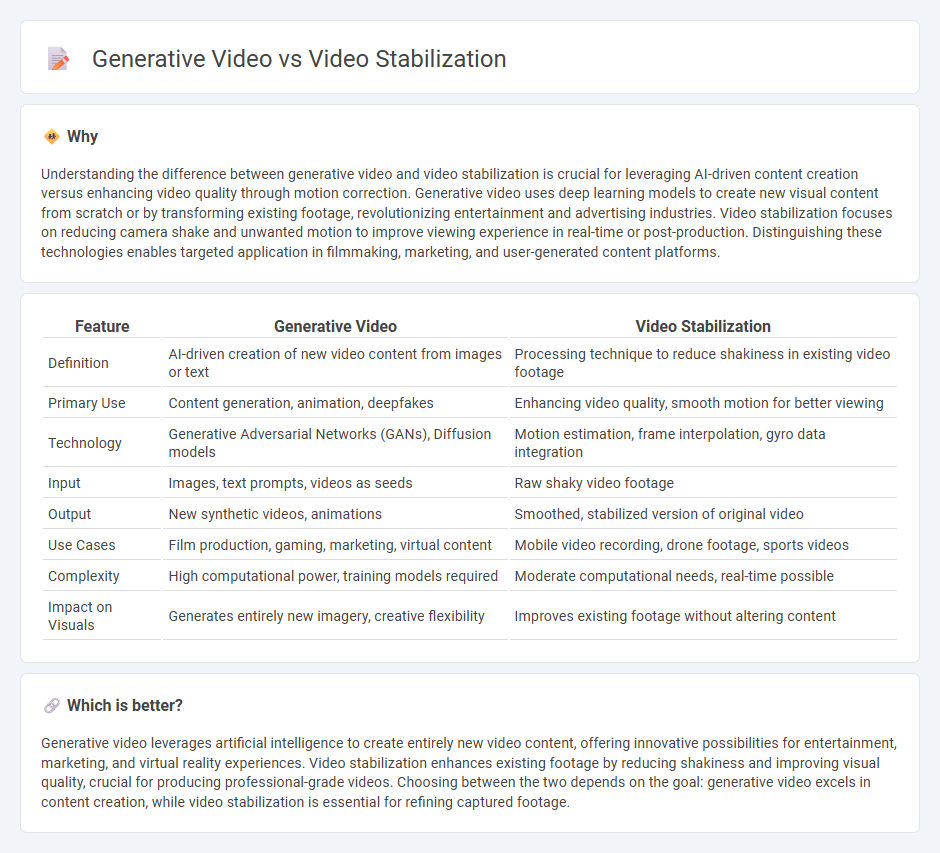
Generative video utilizes artificial intelligence to create entirely new video content by analyzing and synthesizing data from existing footage, while video stabilization focuses on reducing shakiness and smoothening movement in recorded videos to enhance visual quality. Generative video leverages deep learning models, such as GANs, to produce realistic animations and effects, contrasting with stabilization algorithms that employ motion estimation and frame realignment techniques. Explore the distinct technologies behind generative video creation and video stabilization methods to understand their unique applications.
Why it is important
Understanding the difference between generative video and video stabilization is crucial for leveraging AI-driven content creation versus enhancing video quality through motion correction. Generative video uses deep learning models to create new visual content from scratch or by transforming existing footage, revolutionizing entertainment and advertising industries. Video stabilization focuses on reducing camera shake and unwanted motion to improve viewing experience in real-time or post-production. Distinguishing these technologies enables targeted application in filmmaking, marketing, and user-generated content platforms.
Comparison Table
| Feature | Generative Video | Video Stabilization |
|---|---|---|
| Definition | AI-driven creation of new video content from images or text | Processing technique to reduce shakiness in existing video footage |
| Primary Use | Content generation, animation, deepfakes | Enhancing video quality, smooth motion for better viewing |
| Technology | Generative Adversarial Networks (GANs), Diffusion models | Motion estimation, frame interpolation, gyro data integration |
| Input | Images, text prompts, videos as seeds | Raw shaky video footage |
| Output | New synthetic videos, animations | Smoothed, stabilized version of original video |
| Use Cases | Film production, gaming, marketing, virtual content | Mobile video recording, drone footage, sports videos |
| Complexity | High computational power, training models required | Moderate computational needs, real-time possible |
| Impact on Visuals | Generates entirely new imagery, creative flexibility | Improves existing footage without altering content |
Which is better?
Generative video leverages artificial intelligence to create entirely new video content, offering innovative possibilities for entertainment, marketing, and virtual reality experiences. Video stabilization enhances existing footage by reducing shakiness and improving visual quality, crucial for producing professional-grade videos. Choosing between the two depends on the goal: generative video excels in content creation, while video stabilization is essential for refining captured footage.
Connection
Generative video technology enhances video stabilization by creating intermediate frames that smooth motion transitions, reducing shakiness and jitter in footage. Advanced algorithms analyze video sequences to predict and generate stable frames, improving visual coherence and clarity. This synergy enables more seamless and professional-quality video outputs in applications such as filmmaking, virtual reality, and live broadcasting.
Key Terms
Motion compensation
Motion compensation in video stabilization involves analyzing frame-to-frame movements to reduce shakiness and produce smoother footage by aligning and adjusting frames based on detected motion vectors. Generative video techniques utilize motion compensation to predict and synthesize new frames, enhancing visual continuity and enabling creative transformations beyond mere stabilization. Explore the technical advancements in motion compensation to understand how these methods reshape video quality and creativity.
Deep learning
Video stabilization leverages deep learning algorithms to reduce unwanted camera shake and motion artifacts, enhancing visual clarity and smoothness in recorded footage. Generative video models employ deep neural networks to create or alter video content, enabling applications such as frame interpolation, style transfer, and realistic scene synthesis. Discover how deep learning transforms both video stabilization and generative techniques for cutting-edge multimedia experiences.
Frame synthesis
Video stabilization improves footage by reducing unwanted camera shake through frame alignment and motion estimation algorithms, resulting in smoother playback. Generative video leverages AI-driven frame synthesis to create or predict intermediate frames, enhancing video fluidity and enabling advanced effects like slow motion and frame interpolation. Explore how frame synthesis revolutionizes video processing by generating seamless transitions and enriching visual continuity.
Source and External Links
Stabilize a shaky clip in Motion - Use the Stabilize tracking behavior in Apple Motion to smooth shaky video, with options to control analysis quality, stabilization method (stabilize or smooth), and how to handle borders such as cropping or zooming to avoid black edges.
How to stabilize shaky video footage like the pro - VEGAS Pro's Video Stabilization plug-in quickly reduces shake at the media or event level, allowing you to stabilize only the needed portion of your footage for faster processing.
Stabilize shaky videos in minutes with Adobe Premiere Pro. - Apply the Warp Stabilizer effect in Premiere Pro, which automatically analyzes and corrects shake using advanced methods like position, scale, rotation, and even warping parts of the frame for optimal smoothing.
 dowidth.com
dowidth.com